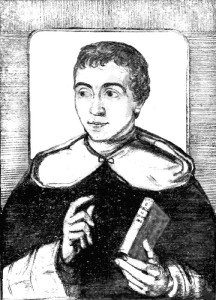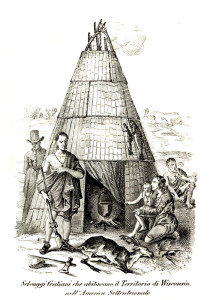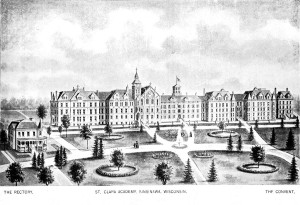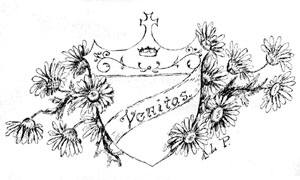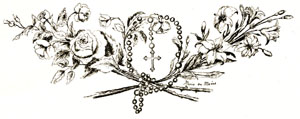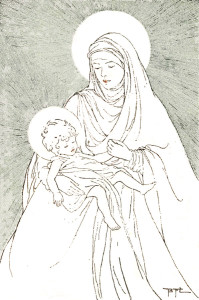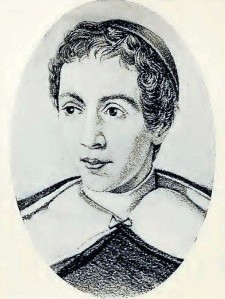Father Mazzuchelli’s story for children, plus coloring pages!
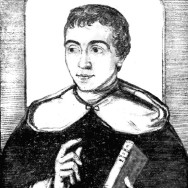
If you are looking for our beautiful coloring pages, scroll down, they are at the bottom! A Catholic mother says this story should be suitable for children who have received their First Holy Communion. It is also a good and lively introduction to Father Mazzuchelli for grown-ups.
Samuel Mazzuchelli [motz-oo-KEL-ly] was born in Italy in the year 1806. His father was a merchant and hoped Samuel would grow up, get married, and follow in the same kind of work. But instead, the boy felt God calling him to the Order of Preachers founded by Saint Dominic, to be a religious brother (friar) and a priest. He went to Rome to learn how to live the disciplined and holy way of life of the Dominican friars, and study all the philosophy and theology, and other subjects he would need to know to be a good priest.
When he found out there were places in the United States that had no priest at all for hundreds of miles around, Samuel strongly wanted to go there to share Jesus’ love with the Indians, fur traders, and pioneer settlers there. He was only 21 years old, and it was a very long distance, and he didn’t even speak English, and he wound up having to go all by himself. He crossed the Atlantic Ocean on a wooden sailing ship. There was a ferocious storm at sea, but young Samuel stood on the deck holding on to the main mast, thrilled by the power of the wind, the tall waves tossing the boat up and down, and the cold spray of salt water splashing him!
Samuel landed in New York City and traveled by stagecoach and river boat, a long way to Cincinatti, Ohio where Bishop Fenwick who was also a Dominican like him was waiting and received him joyfully. A kind American stranger helped him on the way, because he realized the young religious brother didn’t know English, didn’t know how to get to Ohio, and even ran completely out of money. Samuel was deeply thankful, and he learned from other people’s kindness, to be extremely generous to others, too.
After the Bishop ordained Samuel as a priest, in 1830 when he was 23 years old, he sent Father Samuel right away to a tiny settlement in the wilderness in northern Michigan, on Mackinac Island. The people were very surprised that a man so young and who could have had wealth and social status in Italy would sacrifice so much to come and visit them. Though one Protestant minister was upset that a Catholic priest was in town and preached vigorously against Catholicism, the people listened with interest to the truth Father Samuel Mazzuchelli taught them about God. Some people who were already Catholic came back to their Catholic Faith, and well over a thousand Indians asked him to baptize them so they could be part of God’s Church too, and be sons and daughters of God. He said Mass for them in the Indian wigwam houses in the forest in northern Michigan and Wisconsin.
Some non-Christian Indians had problems with getting drunk on the alcohol the fur traders gave them, men having more than one wife, and other sins that caused them a lot of problems, and displeased God. Father Mazzuchelli had compassion and helped many good people to choose to stop sinning and receive Jesus’ great mercy through the Sacraments and then follow Him, loving God and loving their neighbor. The way of life of the Christian Indians was usually more virtuous, and as a result they were happier. The Indians made great Catholics! In fact, when he later wrote a book about his experiences Father Samuel used the Christian good example of the Indians to be an inspiration for his readers in Italy.
No one had ever built any Catholic churches yet in many of the places Father Samuel went, so even though he must have seemed too young to be a church builder, he started asking the local people to help him do just that. He built the very first Catholic church in Wisconsin, in Green Bay. Catholics helped, and Protestant Christians sometimes helped too, even though they believe differently from Catholics. They agreed God is important, churches are important, and friendship and helping one another is important. Eventually, Father Samuel built over 20 churches. It was probably because of his tireless zeal for building churches that his favorite hymn began, in the sacred Latin language, “Quam dilecta tabernacula tua, Domine virtutem!,” that is, “How lovely is your dwelling place, O Lord mighty God!” (click here to hear people singing it in Latin, or click here to read Psalm 84 in English) Some of the Protestants listened carefully to Father Samuel preach and explain the truths of the Catholic Faith, and they wanted to become Catholic and be fully united with God’s holy Church and be able to go to Confession and receive Jesus’ Body Blood Soul and Divinity in Holy Communion. The Catholics warmly welcomed new members. Praise God!
As he traveled through the wilderness, sleeping on the ground at night, sometimes poor Father Samuel ran out of food and went hungry. One time he was canoeing with some Indians who saw a bear and jumped out of the boat and quickly killed it and cooked it for everyone’s dinner, and another time he and his friends riding in a horse-drawn sleigh on the winter ice of the Wisconsin River saw a pack of wolves chase a deer onto the slippery ice and kill it, and they asked the horse to run forward to scare the wolves, and stole the fresh venison for themselves! Another time he had to survive only on bread and butter for a week, because that was all he had. He didn’t complain; it was all so he could go to where people were in the frontier lands, to preach the Gospel and give them God’s grace through the Sacraments. That was what he wanted most.
Only a short time before, there had been bloody wars between some of the Indians and the US government. The government wanted to move the Indians away from the land that had been theirs, to give it to the settlers who were coming in increasing numbers. Father Samuel’s heart went out to the Indians and he even tried to tell the President of the United States to be fair to them–but unfortunately the Indians kept being mistreated anyway. And although a few people were getting rich as fur traders or lead miners, most people in that time and place were extremely poor and suffered from not having their basic needs. Father Samuel was concerned about the harm and anger, and sometimes even fighting caused by that. Jesus tells us we must help the poor. Life could be very rough and tough on the frontier, and everywhere he went, from Michigan to Wisconsin, to northern Iowa and Illinois, Catholics were so comforted and joyful to see a priest. The Irish settlers called him “Father Matthew Kelly,” and he thought that was very funny! They made his name sound Irish. Sometimes his bishop even called him that.
Some of Father Samuel’s friends became important leaders. At the very beginning of his mission, he became friends with Judge Doty, in Green Bay, northern Wisconsin. Though Judge Doty was a Protestant Christian, he and the priest worked together to help alcoholics to stop drinking and be sober and healthy. Wisconsin was not a state yet, and before it could become a state it had to become a territory and begin to have a government and a legislature to make laws. When Judge Doty became part of the first Wisconsin Territorial Legislature, in 1836, Father Samuel was asked to be the first Chaplain to lead prayer for the legislature, even though only a very few of the other people there were Catholic. It was a surprise and an honor and he was delighted! Father Samuel loved America and believed in the American principle of religious freedom, promised by the First Amendment of the US Constitution. Another one of the men at the Wisconsin Territorial Legislature who liked Father Samuel and thought he was very wise, was General George Wallace Jones, a lead miner who agreed to sell Father Samuel a beautiful hill he owned, Sinsinawa Mound [sin-sin-AH-wa]. He hoped to start a seminary there, that is, a school for priests, so there would be many more missionary priests like him.
The work of preaching the truth of Jesus Christ was great and difficult, and Father Samuel needed helpers. In Sinsinawa, Wisconsin, some women made vows of poverty, chastity and obedience as religious sisters. Religious sisters are brides of Christ, their whole heart devoted to Jesus forever as their loving Bridegroom. They would wear a veil and habit as a sign of their consecration, live together as an affectionate and orderly community of friends, pray together, and work as school teachers in southern Wisconsin. Soon, they and good Father Samuel started Saint Clara Academy, a Catholic school for girls in the little town of Benton.
On the frontier, most people weren’t Catholic, and some people even tried to convince Catholics to stop believing in the Catholic Church that Jesus founded, and its teachings, and join Protestant churches. Therefore it was important to give a good education to children that would help them really understand and love the truth and beauty of the Catholic Faith. Father Samuel noticed that there were so many different Protestant groups that all believed different things, that many Protestant Christians had decided that every person should just make up his own mind for himself (or herself), and not worry too much about what religious beliefs were really true. He didn’t want Catholics to get confused in that way, because Saint Paul says in the Bible that God’s Church is the pillar and ground of truth.
Father Samuel was a very heroic priest, and if he heard a Catholic was dying he would travel a very long way so they could have the Sacrament of Anointing of the Sick and the last Holy Communion, which could forgive all their sins and give them great spiritual hep, making them ready to see Jesus in heaven. One time he was carrying the Blessed Sacrament with him in a pouch around his neck, to take to a sick person, when he had to cross some icy water with some other men, in a log canoe. They were far out from shore when they realized the boat had a BIG CRACK in the side and water was pouring in. Some of the men in the boat could not swim, and they were afraid they would drown if it sank! But Father Samuel was not afraid because Jesus was truly with them in the boat in the Blessed Sacrament–he paddled the boat very carefully, and everyone was safe!
One very cold day, Father Samuel Mazzuchelli rode four miles on his horse to give the Sacrament of the Anointing of the Sick and Holy Communion to a Catholic who was dying. He was not dressed warmly enough, and he got very sick with pneumonia. The Sisters nursed him, but after a week of suffering and profound but sometimes joyful prayer, praying to Mary whose own sorrows in her holy life with Jesus stirred him to great devotion, and praying his favorite psalm “Quam dilecta,” he died, on February 23, 1864. He was 57 years old. The Sisters grieved and missed their beloved Father Samuel, but they knew virtuous and holy Christians like him go to eternal life in heaven and are more happy seeing Jesus face to face, than anyone could be on earth, and he will still pray for all of us.
The Dominican Sisters moved Saint Clara Academy to Father Samuel’s beautiful hill in the countryside called Sinsinawa Mound, where they had first made their vows. The seminary Father Samuel tried to start had closed after other Dominican friars didn’t cooperate well, and without Father Samuel they made big mistakes because they were too inexperienced. That was truly unfortunate, but the sisters put the buildings to good use. The smart, kind, energetic and holy priest had given the sisters such a good start that many more women joined them. They called the head sister “Mother” because she loved them and they were obedient to her, and some great women filled this role, like Mother Mary Emily Power in the last part of the 1800s, and Mother Mary Samuel Coughlin in the first part of the 1900s. They opened many more Catholic schools, and taught children with loving kindness. Soon there were 100 sisters, and then 1000, and by 1965 there were over 1900!
The Sisters still haven’t forgotten Father Samuel Mazzuchelli. They and many other people love him now as much as ever, and wish their lives could be a little more like his. It’s no wonder, since Father Samuel was a lot like the one he humbly served and worshiped: Jesus!
- Can you think of some of the ways Father Samuel’s life was like the life of Jesus?
- Father Samuel could have had a very comfortable life if he’d stayed in Italy. Because he was willing to be poor and accept sacrifices and sufferings, he was more available to God and to be of help and service to other people–and the people he met noticed that he loved them more than he loved his own comforts, and they were really pleased. Can you think of any ways that being less attached to, or even letting go of some things that you find comfortable or fun would actually free you up to spend more time talking to and listening to God in loving prayer, and being generous and good to others?
- Father Samuel studied a lot to be a good priest, and he started schools to teach children in southern Wisconsin. Why is study and learning important? Can you think of how it can help us to love God and our neighbor better?
- How can we be respectful, kind and good to people who might seem different from us, like Father Samuel deeply respected the Indians, or to people who believe differently, like Father Samuel was warm and friendly toward the Protestant Christians? Is there anything kind you could do for or say to another child who you hadn’t wanted to talk to before because they were different?
- Jesus told his disciples or followers, including us, to make disciples of all nations. Missionaries should be courageous and cheerful, and not discouraged when some people won’t listen to the truth. Missionaries should be merciful and forgiving. And good missionaries should live all the teachings of the Catholic Faith, serve other people’s needs more than their own, and keep growing in virtue. Have you ever tried to tell someone about Jesus and the Catholic Church? How can you grow to be a better Christian and a better missionary?
—
Catholic Coloring Pages
You can color Father Samuel Mazzuchelli, the Catholic Wisconsin Indians, Saint Clara Academy at Sinsinawa Mound in the old days, student drawings from Saint Clara Acadamy, and Mary and Baby Jesus from the sisters’ 1927 Rosary Readers Primer (click if you want to download that whole book, it’s so sweet)! Click on the pictures below to see them much bigger, and then print the big picture. Color and have fun!



